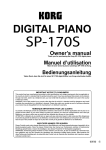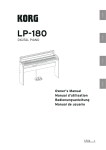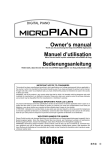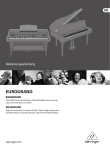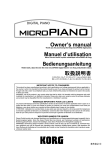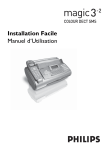Download Korg SP-170 User's Manual
Transcript
DIGITAL PIANO Owner’s manual Manuel d’utilisation Bedienungsanleitung MIDI implementation chart E F G 1 Precautions Location Using the unit in the following locations can result in a malfunction. •In direct sunlight •Locations of extreme temperature or humidity •Excessively dusty or dirty locations •Locations of excessive vibration •Close to magnetic fields Power supply Please connect the designated AC adapter to an AC outlet of the correct voltage. Do not connect it to an AC outlet of voltage other than that for which your unit is intended. Interference with other electrical devices Radios and televisions placed nearby may experience reception interference. Operate this unit at a suitable distance from radios and televisions. Handling To avoid breakage, do not apply excessive force to the switches or controls. Care If the exterior becomes dirty, wipe it with a clean, dry cloth. Do not use liquid cleaners such as benzene or thinner, or cleaning compounds or flammable polishes. Keep this manual After reading this manual, please keep it for later reference. Keeping foreign matter out of your equipment Never set any container with liquid in it near this equipment. If liquid gets into the equipment, it could cause a breakdown, fire, or electrical shock. Be careful not to let metal objects get into the equipment. If something does slip into the equipment, unplug the AC adapter from the wall outlet. Then contact your nearest Korg dealer or the store where the equipment was purchased. THE FCC REGULATION WARNING (for USA) This equipment has been tested and found to comply with the limits for a Class B digital device, pursuant to Part 15 of the FCC Rules. These limits are designed to provide reasonable protection against harmful interference in a residential installation. This equipment generates, uses, and can radiate radio frequency energy and, if not installed and used in accordance with the instructions, may cause harmful interference to radio communications. However, there is no guarantee that interference will not occur in a particular installation. If this equipment does cause harmful interference to radio or television reception, which can be determined by turning the equipment off and on, the user is encouraged to try to correct the interference by one or more of the following measures: • Reorient or relocate the receiving antenna. • Increase the separation between the equipment and receiver. • Connect the equipment into an outlet on a circuit different from that to which the receiver is connected. • Consult the dealer or an experienced radio/TV technician for help. Unauthorized changes or modification to this system can void the user’s authority to operate this equipment. Notice regarding disposal (EU only) When this “crossed-out wheeled bin” symbol is displayed on the product, owner’s manual, battery, or battery package, it signifies that when you wish to dispose of this product, manual, package or battery you must do so in an approved manner. Do not discard this product, manual, package or battery along with ordinary household waste. Disposing in the correct manner will prevent harm to human health and potential damage to the environment. Since the correct method of disposal will depend on the applicable laws and regulations in your locality, please contact your local administrative body for details. If the battery contains heavy metals in excess of the regulated amount, a chemical symbol is displayed below the “crossed-out wheeled bin” symbol on the battery or battery package. IMPORTANT NOTICE TO CONSUMERS This product has been manufactured according to strict specifications and voltage requirements that are applicable in the country in which it is intended that this product should be used. If you have purchased this product via the internet, through mail order, and/or via a telephone sale, you must verify that this product is intended to be used in the country in which you reside. WARNING: Use of this product in any country other than that for which it is intended could be dangerous and could invalidate the manufacturer’s or distributor’s warranty. Please also retain your receipt as proof of purchase otherwise your product may be disqualified from the manufacturer’s or distributor’s warranty. * All product names and company names are the trademarks or registered trademarks of their respective owners. 2 Internal Setup and Connections Figure 1 1. Connecting the Power (Figure 1) Cord hook • DC plug AC adapter Pass the AC adapter cord through the cord hook so that the plug will not be removed from the jack accidentally. When you unhook the cord, do not pull the cord with force. Be careful not to bend this part too much when you hook the power cord. Be sure to use the supplied AC adapter. Using other AC adapters may cause the unit to malfunction. Power cord for AC adapter To AC outlet Figure 2 Volume knob Be sure to plug the unit into an AC outlet of an appropriate voltage. 2.Turning the SP-170 ON • Set the power switch on the rear panel to the “ON” position. (Figure 2) The power LED located to the left of the music stand will light up. (Figure 3) • To turn the unit off, set the power switch to “STANDBY.” The power LED will go dark. Headphone jacks Power switch Figure 3 Power LED Start with the SP-170 turned OFF. Connect the supplied AC adapter to the power cord. Insert the DC plug end into the [DC12V] jack on the rear panel. Next, plug the power cord into an AC outlet. 3. Adjust the volume • Rotate the [VOLUME] knob on the rear panel clockwise toward “MAX” to raise the volume level. Rotate it counter-clockwise toward “MIN” to lower the level. (Figure 2) The [VOLUME] knob controls the output level of the built-in speakers and the headphones jacks. ■ Using headphones When you plug in headphones, the built-in speakers will be muted. This is useful when you want to play the keyboard in the evening without bothering your family or neighbors. The SP-170 features two headphone jacks so that two people can enjoy playing and listening. • Insert the stereo headphone plug into one of the [PHONES] jacks on the rear panel. (Figure 2) If your headphones feature a standard-to-mini adapter plug, be sure to hold the adapter plug when you connect or disconnect the headphones. To protect your hearing, do not listen to loud, high-volume sounds for a long period of time through headphones. ■ Connecting audio components Figure 4 You can use the [PHONES] jacks as line-out jacks to connect powered speakers or audio components to the keyboard. For such connections, use commercially-available cables that are appropriate for the components. Before connecting audio components, make sure that you turn off the power to the unit and the audio components. Otherwise, damage or malfunction to the unit or components may occur. ■ Using the music stand • Insert the legs of the supplied music stand into the dedicated groove located in the middle of the top panel. (Figure 4) 3 Playing Different Sounds E. Piano 2 Vibraphone E. Organ Piano 2 The SP-170 features 10 preset sounds. While simultaneously pressing and holding down the A#7, B7, and C8 keys (at the right end of the keyboard), press one of the keys ranging from C7 to A7. The preset sound assigned to the key that you pressed will be selected. Whenever you turn on the power to the unit, the default preset sound (Piano 1) will be recalled. Press these simultaneously Strings P. Organ Clav Harpsi E. Piano 1 Piano 1 Piano 1: Elegant and warm grand piano Piano 2: Clear and bright grand piano E. Piano 1: Smooth, authentic electric piano E. Piano 2: Modern, percussive electric piano Harpsi: Classical harpsichord Clav: Expressive electric clavichord Vibraphone: Smooth vibraphone P. Organ: Pipe organ E. Organ: Drawbar electronic organ Strings: Ensemble string section Playing Back Demo Songs The SP-170 features 10 demo songs that use 10 preset sounds. Play back the demo songs to discover rich and expressive sounds. While pressing and holding down the A#7, B7, and C8 keys (at the right end of the keyboard), press one of the keys ranging from C6 to A6. The demo song assigned to the key you pressed (as shown below) will start playing. Playback starts from the selected song, then continues and repeats all demo songs in ascending order until you stop the playback. To stop the playback of the demo song, press the A#7, B7, and C8 keys simultaneously. 2 4 7 9 1 3 5 6 8 10 Press these simultaneously Demo 1 (Piano 1): Fantaisie-Impromptu Op.66 /F.Chopin Demo 2 (Piano 2): Amazing Grace/unknown (arr. : N.Nishi) Demo 3 (E. Piano 1): Ramble /M.Sakaguchi Demo 4 (E. Piano 2): KORG Orignal Demo 5 (Harpsi): Invention No.8/J.S.Bach Demo 6 (Clav): KORG Original Demo 7 (Vibraphone): KORG Original Demo 8 (P. Organ) : Toccata in D moll/J.S.Bach Demo 9 (E. Organ) : KORG Original Demo 10 (Strings) : First Snow /M.Sakaguchi Using a Damper Pedal Damper switch jack 4 You can use the supplied pedal as a damper pedal by connecting it to the [DAMPER SW] jack on the rear panel of the unit. While you press the pedal, the sound will sustain, creating a rich, lingering sound. Alternatively, you can use an optional DS-1H damper pedal. A half-pedal damper effect can be applied to Piano 1 or 2. Using Other Functions About the confirmation sound When you press and hold down the A #7, B7, and C8 keys simultaneously at the right end of the keyboa rd, or you pr e s s a key where a f unct ion has been assigned, you will hear the confirmation sound. You can turn this sound off, as described below. While simultaneously pressing and holding down the A#7, B7, and C8 keys, press the A# 0 to turn off the confirmation sound. To turn on the confirmation sound, repeat the previous procedure but press the B0 instead of A# 0. The default setting (when you turn on the unit) is "Confirmation sound On.” In addition to selecting a preset sound or demo song, the SP-170 enables you to use various functions by pressing and holding down the A#7, B7, and C8 keys and pressing a key to where the corresponding function has been assigned. Please refer to the “MIDI” section on the next page for more information on MIDI channels and program change messages. While pressing and holding down the A#7, B7, and C8 keys, do not play the keyboard. Otherwise, you might get an unexpected result. Effects (Reverb and Chorus) You can use a reverb effect to add reverberation and depth to the sound, and a chorus effect to add width and space. • • While simultaneously pressing and holding down the A#7, B7, and C8 keys, press the A5 key to turn on the reverb effect. To turn off the reverb effect, repeat the previous procedure but press the C# 5 key instead of A5. While simultaneously pressing and holding down the A#7, B7, and C8 keys, press the B5 key to turn on the chorus effect. To turn off the chorus effect, repeat the previous procedure but press the A# 5 key instead of B5. You can apply effects to each preset sound. When you turn on the power to the unit, the effects will use the optimum settings for each preset sound. Key Touch Control function The Key Touch Control function enables you to change the way your playing strength affects the sound output level. You can set this function using the white keys in a range from D2 to F2. (See the figure on the left.) Loud Loudness Light Quiet Quiet • Standard Heavy Playing strength • Loud • To play fortissimo with soft strokes (Light touch), press and hold down the A#7, B7, and C8 keys (at the right end of the keyboard), and press the D2 key. To play fortissimo with very strong strokes (Heavy touch), press and hold down the A#7, B7, and C8 keys, and press the F2 key. To simulate a normal piano touch (Standard touch), press and hold down the A#7, B7, and C8 keys, and press the E2 key. The default setting (when you turn on the unit) is Standard touch. Transpose function (Shifting the key) F3 key +5 semitones. Playing the C3 key will sound the F3 pitch. C3 key 0. Normal state. # F 2 key -6 semitones. Playing the C3 # key will sound the F 2 pitch. In some cases, a song may be written in a difficult key (e.g., using many black keys), or you may wish to shift the key to match another instrument or vocalist. In such cases, you can transpose (shift the key) to use an easier fingering (without playing too many black keys), or to use the same familiar fingering to play in a different key. This is called the Transpose function. You can shift the key in a range of eleven semitones. For example if you transpose upward by one semitone, playing the notes shown in the upper score to the left will produce the pitches shown in the lower score. • To transpose the key, press and hold down the A#7, B7, and C8 keys, and press a key from F#2 to B3 or from C# 3 to F3. The name of the key that you pressed will become the transposed key. For example, if you wish to use the C3 key to play note A2 (lower by three semitones), press and hold down the A#7, B7, and C8 keys, and press the A2 key. If you wish to use the C3 key to play note D# 3 (higher by three semitones), press and hold down the A#7, B7, and C8 keys, and press the D# 3 key. To reset the Transpose function to “No Transposition (+/-0),” press and hold down the A#7, B7, and C8 keys, and press the C3 key. The default setting (when you turn on the unit) is “No Transposition.” 5 Pitch Control function (Tuning) You can adjust the tuning of the SP-170 in half-step (0.5) Hz intervals over a range of 427.5 - 452.5 Hz (Hertz) by using the E5 and F5 keys. Here's how to make fine adjustments to the pitch. When you're playing together with other instruments, you can use this method to fix any slight differences in pitch between instruments. • • While pressing and holding down the A#7, B7, and C8 keys (on the right end of the keyboard), press the E5 key repeatedly to lower the pitch in 0.5Hz steps, or the F5 key repeatedly to raise the pitch in 0.5Hz steps. To reset the pitch to 440Hz, press and hold down the A#7, B7, and C8 keys, and press the E5 and F5 keys simultaneously. The default setting (when you turn on the unit) is A4=440Hz. MIDI Using the MIDI OUT jack The MIDI OUT jack transmits MIDI messages. When you play the keyboard, the MIDI messages will be output to control (e.g, play the sound of) an external MIDI device. Use an optional MIDI cable to connect the MIDI OUT jack of the SP-170 to the MIDI IN jack of an external MIDI device. BANK# PC# Sound Piano 1 0 0 0 1 Piano 2 0 4 E. Piano 1 0 5 E. Piano 2 0 6 Harpsi 0 7 Clav 0 11 Vibraphone 0 19 P. Organ 0 16 E. Organ 0 48 Strings Changing the MIDI channel If you're using the SP-170 as a controller to play the sound from a connected MIDI device, the MIDI channel of the SP-170 must match that of the external MIDI device. To change the MIDI channel (1-16) that MIDI data is being transmitted from via the MIDI OUT jack on the rear panel, press and hold down the A#7, B7, and C8 keys simultaneously, and press one of the keys ranging from C4 to D# 5. The default MIDI channel (when you turn on the unit) is “1.” Transmitting Program Change and Control Change messages CC0: Ba n k Select (MSB) for each sound is assigned to 121. You can change the program number of the connected MIDI device from the SP-170. When you select a preset sound on the SP-170 (see “Playing Different Sounds” on page 4), it transmits a MIDI Program Change number (PC#) as shown in the table on the left. To disable this transmission (DIS), press and hold down the A#7, B7, and C8 keys simultaneously, and press the G # 3 key. To enable this transmission (ENA), repeat the previous procedure but press the A3 key instead. The SP-170 also transmits Control Change messages to control Damper (CC64), Bank Select (CC64), etc. of the connected MIDI device. To disable this transmission (DIS), press and hold down the A#7, B7, and C8 keys simultaneously, and press the A# 3 key. To enable this transmission (ENA), repeat the previous procedure but press the B3 key instead. The default setting (when you turn on the unit) is ENA (transmitted) for both Program and Control Change messages. Key Functions � [ ]* indicates MIDI Note number. � Key Touch B0 C1[24]* Confirmation sound On/Off C2[36]* D2 E2 F2 A A B C � C D D � � 4 2 E Transpose (F 2–F3) C3[48]* DIS � F ENA On Light Std. Heavy G � G A3 DIS � F 6 � G3 Off A0 A3 ENA Program Change Table B3 1 3 7 5 MIDI C4[60]* Enabling/Disabling Enabling/Disabling Program Change Control Change transmission transmission 6 8 Troubleshooting If you suspect any malfunction, check the following suggestions. If the problem persists, contact your nearest Korg distributor. Power does not turn on · Make sure that the AC adapter is properly connected to the SP-170 and the AC outlet. · Make sure that the power switch on the rear panel is set to ON. No sound from the speakers · Rotate the [VOLUME] knob on the rear panel toward MAX. · The speakers will be muted if the headphones are connected. Sound is interrupted · The preset sounds of the SP-170 have been created by sampling (recording) the sounds of actual instruments, then analyzing and processing the samples. When you press a key, some sounds play a single piece of sampled data, while other sounds play two pieces of sampled data. The SP-170 uses two pieces of data for most of its preset sounds. When one of these two-sample sounds is selected (regardless of whether the damper pedal is being pressed), the maximum polyphony is 60 notes. However, with two Piano sounds, the maximum polyphony is 120 notes. If the maximum polyphony is exceeded, some of the notes will be lost. The pitch or tone of the piano sounds wrong in some key regions · The SP-170’s piano sounds replicate the sound of an actual piano as faithfully as possible. This means that in some regions of the keyboard, you may feel that the overtones seem stronger, or that the tone or pitch seems wrong. This is not a malfunction. · Make sure that the pedal cable is properly connected. Pedal is not effective Connected MIDI device does not respond to MIDI messages · Make sure that all MIDI cables are properly connected. · Make sure that the SP-170 is transmitting MIDI data on the same MIDI channel as that of the connected MIDI device. Specifications Keyboard NH Keyboard: 88 note (A0–C8) Sounds Ten sounds Jacks Headphones x 2 (also function as outputs), MIDI OUT, Pedal (Damper) Amp output 9 W × 2 Speakers Oval (10cm x 5cm) x 2 Power supply DC 12 V Power Consumption 9W Weight 12. 1 kg / 26. 68 lbs. Dimensions (W x D x H) 1312 × 325 × 133 mm / 51. 65" × 12. 8" × 5. 24" Maximum polyphony 120 notes /60 notes (Stereo) Included items AC adapter, Music stand, Pedal � MIDI Channel (C4–D 5) C5[72]* Off 15 Down Up F5 Reverb On/Off 3 5 6 8 10 Demo Songs (C6–A6) Pitch E5 1 E5 G5 C6[84]* Chorus On/Off Vibraphone P. Organ E. Organ Strings 13 9 Clav 12 7 E. Piano 2 Harpsi 10 4 2 E. Piano 1 8 16 16 Piano 1 6 14 On 5 11 On 9 7 � G5 Off � A5 Piano 2 * Korg reserves the right to change the specifications without notice. Preset Sounds (C7–A7) C7[96]* Settings Press these simultaneously C8[108]* 7 Précautions Emplacement L’utilisation de cet instrument dans les endroits suivants peut en entraîner le mauvais fonctionnement. •En plein soleil •Endroits très chauds ou très humides •Endroits sales ou fort poussiéreux •Endroits soumis à de fortes vibrations •A proximité de champs magnétiques Alimentation Branchez l’adaptateur secteur fourni à une prise secteur de tension appropriée. Evitez de brancher l’adaptateur à une prise de courant dont la tension ne correspond pas à celle pour laquelle l’appareil est conçu. Interférences avec d’autres appareils électriques Les postes de radio et de télévision situés à proximité peuvent par conséquent souffrir d’interférences à la réception. Veuillez dès lors faire fonctionner cet appareil à une distance raisonnable de postes de radio et de télévision. Maniement Pour éviter de les endommager, manipulez les commandes et les boutons de cet instrument avec soin. Entretien Lorsque l’instrument se salit, nettoyez-le avec un chiffon propre et sec. Ne vous servez pas d’agents de nettoyage liquides tels que du benzène ou du diluant, voire des produits inflammables. Conservez ce manuel Après avoir lu ce manuel, veuillez le conserver soigneusement pour toute référence ultérieure. Evitez toute intrusion d’objets ou de liquide Ne placez jamais de récipient contenant du liquide près de l’instrument. Si le liquide se renverse ou coule, il risque de provoquer des dommages, un court-circuit ou une électrocution. Veillez à ne pas laisser tomber des objets métalliques dans le boîtier (trombones, par ex.). Si cela se produit, débranchez l’alimentation de la prise de courant et contactez votre revendeur korg le plus proche ou la surface où vous avez acheté l’instrument. 8 Note concernant les dispositions (Seulement EU) Quand un symbole avec une poubelle barrée d’une croix apparait sur le produit, le mode d’emploi, les piles ou le pack de piles, cela signifie que ce produit, manuel ou piles doit être déposé chez un représentant compétent, et non pas dans une poubelle ou toute autre déchetterie conventionnelle. Disposer de cette manière, de prévenir les dommages pour la santé humaine et les dommages potentiels pour l'environnement. La bonne méthode d'élimination dépendra des lois et règlements applicables dans votre localité, s’il vous plaît, contactez votre organisme administratif pour plus de détails. Si la pile contient des métaux lourds au-delà du seuil réglementé, un symbole chimique est affiché en dessous du symbole de la poubelle barrée d’une croix sur la pile ou le pack de piles. REMARQUE IMPORTANTE POUR LES CLIENTS Ce produit a été fabriqué suivant des spécifications sévères et des besoins en tension applicables dans le pays où ce produit doit être utilisé. Si vous avez acheté ce produit via l’internet, par vente par correspondance ou/et vente par téléphone, vous devez vérifier que ce produit est bien utilisable dans le pays où vous résidez. ATTENTION: L’utilisation de ce produit dans un pays autre que celui pour lequel il a été conçu peut être dangereuse et annulera la garantie du fabricant ou du distributeur. Conservez bien votre récépissé qui est la preuve de votre achat, faute de quoi votre produit ne risque de ne plus être couvert par la garantie du fabricant ou du distributeur. * Tous les noms de produits et de sociétés sont des marques commerciales ou déposées de leur détenteur respectif. Installation et connexions Illustration 1 Crochet pour câble 1. Connexion au secteur (Illustration 1) • Fiche CC Faites passer le câble de l’adaptateur par le crochet prévu à cet effet pour éviter que la fiche ne se débranche accidentellement. Lorsque vous retirez le câble du crochet, évitez de tirer sur le câble avec une force excessive. Veillez à ne pas plier cette partie excessivement lorsque vous fixez le câble au crochet. Adaptateur secteur Utilisez uniquement l’adaptateur secteur fourni. L’utilisation d’un autre adaptateur risque d’entraîner des dysfonctionnements. Câble de l’adaptateur secteur A une prise de courant Commande de volume Illustration 2 Prises pour casques Interrupteur Illustration 3 Témoin Pour commencer, le SP-170 est hors tension. Branchez le câble d’alimentation à l’adaptateur secteur. Branchez la fiche de CC à la prise [DC12V] en face arrière. Branchez ensuite le câble d’alimentation à une prise secteur. Veillez à brancher le produit à une prise secteur d’une tension adéquate. 2. Mise sous tension du SP-170 • Réglez l’interrupteur d’alimentation en face arrière sur “ON”. (Illustration 2) Le témoin d’alimentation situé à gauche du pupitre s’allume. (Illustration 3) • Pour mettre l’instrument hors tension, réglez son interrupteur sur “STANDBY”. Le témoin d’alimentation s’éteint. 3. Réglage du volume • d’alimentation Tournez la commande [VOLUME] située en face arrière vers la position “MAX” pour augmenter le volume. Tournez-la vers “MIN” pour diminuer le volume. (Illustration 2) La commande [VOLUME] règle le volume des haut-parleurs internes et des prises pour casques. ■ Utilisation de casques La connexion d’un casque coupe les haut-parleurs internes. Cela permet de jouer du clavier le soir sans déranger votre entourage. Le SP-170 dispose de deux prises pour casques, permettant à deux personnes d’écouter au casque. • Branchez la fiche de casque stéréo à une des prises [PHONES] en face arrière. (Illustration 2) Si votre casque est doté d’une fiche adaptatrice jack standard/mini-jack, veillez à tenir la fiche adaptatrice lorsque vous branchez ou débranchez le casque. Pour protéger votre ouïe, évitez une écoute au casque prolongée à volume élevé. ■ Connexion de périphériques audio Illustration 4 Vous pouvez utiliser les prises [PHONES] comme sorties lignes pour brancher des enceintes actives ou d’autres périphériques audio au clavier. Utilisez pour cela des câbles conçus pour ces périphériques et disponibles dans le commerce. Avant de brancher des périphériques audio, n’oubliez pas de mettre l’instrument et les périphériques audio hors tension. Faute de quoi, vous risquez d’endommager l’instrument ou les périphériques. ■ Utilisation du pupitre • Insérez les pieds du pupitre fourni dans la fente située au centre du panneau supérieur. (Illustration 4) 9 Jouer avec différents sons E. Piano 2 Vibraphone E. Organ Piano 2 Le SP-170 propose 10 sons préprogrammés. En maintenant les touches La#7, Si7 et Do8 enfoncées simultanément, appuyez sur une des touches situées entre Do7 et La7. Le son assigné à la touche actionnée est sélectionné. Quand vous mettez l’instrument sous tension, le son “Piano 1” est sélectionné par défaut. Enfoncez ces touches simultanément Strings P. Organ Clav Harpsi E. Piano 1 Piano 1 Piano 1: Piano à queue chaud et riche Piano 2: Piano à queue clair et brillant E. Piano 1: Piano électrique authentique et fluide E. Piano 2: Piano électrique moderne et percutant Harpsi: Clavecin classique Clav: Clavicorde électrique expressif Vibraphone: Vibraphone au son velouté P. Organ: Orgue à tuyaux E. Organ: Orgue électronique à registres Strings: Section de cordes Ecouter les morceaux de démonstration Le SP-170 propose 10 morceaux de démonstration exploitant 10 sons préprogrammés. Ecoutez les morceaux de démonstration pour découvrir toute la richesse et l’expressivité des sons. En maintenant les touches La#7, Si7 et Do8 enfoncées, appuyez sur une des touches situées entre Do6 et La6. Le morceau de démonstration assigné à la touche actionnée (voyez ci-dessous) démarre. La lecture des morceaux de démonstration commence à partir du morceau sélectionné et se poursuit par ordre ascendant jusqu’à ce que vous l’arrêtiez. Pour arrêter la lecture des morceaux de démonstration, appuyez simultanément sur les touches La#7, Si7 et Do8. 2 4 7 9 1 3 5 6 8 10 Enfoncez ces touches simultanément Demo 1 (Piano 1): Fantaisie-Impromptu Op.66 /F.Chopin Demo 2 (Piano 2): Amazing Grace/unknown (arr. : N.Nishi) Demo 3 (E. Piano 1): Ramble /M.Sakaguchi Demo 4 (E. Piano 2): KORG Original Demo 5 (Harpsi): Invention No.8/J.S.Bach Demo 6 (Clav): KORG Original Demo 7 (Vibraphone): KORG Original Demo 8 (P. Organ): Toccata in D moll/J.S.Bach Demo 9 (E. Organ): KORG Original Demo 10 (Strings): First Snow /M.Sakaguchi Pédale forte Prise pour pédale forte 10 Vous pouvez utiliser la pédale commutateur fournie comme pédale forte en la branchant à la prise [DAMPER SW] en face arrière. Quand vous enfoncez la pédale, le son est maintenu dans toute sa richesse. Vous pouvez aussi utiliser une pédale Damper (maintien) DS-1H disponible en option. Un effet de pédale forte progressive peut être appliqué au son Piano 1 ou 2. Autres fonctions Sonorité de confirmation Quand vous enfoncez simultanément les touches La#7, Si7 et Do8 à l’extrémité droite du clavier ou quand vous act ion nez une touche à laquelle une fonction est assignée, vous entendez une sonorité de confirmation. Vous pouvez couper cette sonorité en procédant de la façon suivante. En maintenant les touches La #7, Si7 et Do8 enfoncées simultanément, appuyez sur la touche La# 0 pour couper la sonorité de confirmation. Pour réactiver la sonorité de confirmation, faites de même mais appuyez sur la touche Si0 au lieu de La# 0. Par défaut (à la mise sous tension), la sonorité de confirmation est activée. Outre la sélection de sons ou de morceaux de démonstration, le SP-170 permet d’accéder à diverses fonctions en maintenant les touches La#7, Si7 et Do8 enfoncées et en actionnant une touche à laquelle une fonction est assignée. Voyez la section “MIDI” à la page suivante pour en savoir plus sur les canaux et les changements de programme MIDI. Tant que vous maintenez les touches La#7, Si7 et Do8 enfoncées, ne jouez pas sur le clavier. Vous risquez d’obtenir un résultat inattendu. Effets (réverbération et chorus) Vous pouvez utiliser un effet de réverbération pour conférer plus de profondeur au son ou un effet chorus pour l’élargir et l’enrichir. • • En maintenant les touches La#7, Si7 et Do8 enfoncées simultanément, appuyez sur la touche La5 pour activer l’effet de réverbération. Pour couper l’effet de réverbération, faites de même mais appuyez sur la touche Do# 5 au lieu de La5. En maintenant les touches La#7, Si7 et Do8 enfoncées simultanément, appuyez sur la touche Si5 pour activer l’effet de chorus. Pour couper l’effet de chorus, faites de même mais appuyez sur la touche La# 5 au lieu de Si5. Vous pouvez ajouter des effets à chacun des sons. Quand vous mettez l’instrument sous tension, les effets utilisent des réglages optimisés pour chacun des sons préprogrammés. Réglage de la réponse du clavier selon le toucher Fort Le réglage de la réponse du clavier vous permet de déterminer le rapport entre la force exercée sur les touches (toucher) et le niveau de sortie du son. Vous pouvez régler ce paramètre avec les touches blanches de la plage Ré2~Fa2. (Voyez l’illustration à gauche.) Puissance sonore Léger Std. • Lourd Calme Calme Force du jeu Fort • • Pour jouer fortissimo avec un toucher léger, maintenez les touches La #7, Si7 et Do8 enfoncées (à l’extrémité droite du clavier) et actionnez la touche Ré2. Pour jouer fortissimo avec un toucher lourd, maintenez les touches La#7, Si7 et Do8 enfoncées (à l’extrémité droite du clavier) et actionnez la touche Fa2. Pour un toucher normal (standard), maintenez les touches La#7, Si7 et Do8 enfoncées et actionnez la touche Mi2. Le toucher standard est le réglage par défaut (à la mise sous tension). Transposition (décalage de hauteur) Il peut arriver qu’un morceau soit écrit dans une tonalité difficile (impliquant de nombreuses altérations) ou que vous souhaitiez adapter la hauteur à celle d’un autre instrument ou d’un chanteur. Dans ce cas, vous pouvez transposer le clavier (décaler la hauteur des notes) afin de pouvoir jouer comme vous en avez l’habitude mais dans une tonalité différente. C’est ce que nous appelons la fonction de transposition. Vous pouvez transposer la tonalité sur une plage de 11 demi-tons. Après une transposition vers le haut d’un demi-ton, le fait de jouer les notes de la portée supérieure produit les notes de la portée inférieure. F3 key + 5 demi-tons. Quand vous jouez C3, vous entendrez le son de F3. C3 key 0. État normal. # F 2 key -6 demi-tons. Quand vous jouez # C3, vous entendrez le son de F 2. • Pour effectuer la transposition, maintenez les touches La#7, Si7 et Do8 enfoncées et appuyez sur une touche de la plage Fa#2~Si3 ou Do#3~Fa3. La transposition est effectuée par rapport à une note de référence. Si vous souhaitez une transposition telle que la touche Do3 (référence) produise la note La2 (transposition vers le bas de trois demi-tons), maintenez les touches La#7, Si7 et Do8 enfoncées et appuyez sur la touche La2. Si vous souhaitez une transposition telle que la touche Do3 (référence) produise la note Ré#3 (transposition vers le haut de trois demi-tons), maintenez les touches La#7, Si7 et Do8 enfoncées et appuyez sur la touche Ré#3. Pour annuler la transposition (±0), maintenez les touches La#7, Si7 et Do8 enfoncées et appuyez sur la touche Do3. Par défaut (à la mise sous tension), il n’y a pas de transposition. 11 Réglage du diapason Vous pouvez modifier le diapason du SP-170 par intervalles de 0,5Hz (Hertz) sur la plage 427,5~452,5Hz en utilisant les touches Mi5 et Fa5. La fonction de contrôle de tonalité intégrée vous permet d’effectuer des régla-ges précis de la tonalité du SP-170. Vous pouvez utiliser cette fonction pour, parexemple, régler le SP-170 afn de le syntoniser avec d’autres instruments. • • En maintenant les touches La#7, Si7 et Do8 enfoncées (à l’extrémité droite du clavier), appuyez plusieurs fois sur la touche Mi5 pour diminuer le diapason par pas de 0,5Hz ou sur la touche Fa5 pour augmenter le diapason par pas de 0,5Hz. Pour retrouver le diapason La4= 440Hz, maintenez les touches La#7, Si7 et Do8 enfoncées et appuyez simultanément sur les touches Mi5 et Fa5. Par défaut (à la mise sous tension), le diapason est réglé sur La4=440Hz. MIDI Utiliser la prise MIDI OUT La prise MIDI OUT transmet des messages MIDI. Les messages MIDI produits et transmis lorsque vous jouez sur le clavier peuvent piloter un dispositif MIDI (pour jouer avec les sons d’un module externe, par exemple). Utilisez un câble MIDI optionnel pour brancher la prise MIDI OUT du SP-170 à la prise MIDI IN d’un autre dispositif MIDI. 0 1 Piano 2 0 4 E. Piano 1 0 5 E. Piano 2 0 6 Harpsi 0 7 Clav 0 11 Vibraphone 0 19 P. Organ 0 16 E. Organ 0 48 Strings Transmission de changements de programme et de commandes de contrôle CC0: La banque sélectionnée (MSB) pour tous les sons internes est “121”. Vous pouvez changer le numéro de programme utilisé par le dispositif MIDI externe à partir du SP-170. Quand vous sélectionnez un son sur le SP-170 (voyez “Jouer avec différents sons” à la page 10), vous transmettez un des numéros de programme MIDI (“PC”) indiqués dans le tableau ci-contre. Pour désactiver (DES) cette transmission, maintenez les touches La#7, Si7 et Do8 enfoncées et appuyez sur la touche Sol# 3. Pour activer (ACT) cette transmission, faites de même mais appuyez sur la touche La3. Le SP-170 transmet également des commandes de contrôle permettant de piloter la fonction “Damper” (CC64), la sélection de banque (CC00) etc. sur le dispositif MIDI branché. Pour désactiver (DES) cette transmission, maintenez les touches La#7, Si7 et Do8 enfoncées et appuyez sur la touche La# 3. Pour activer (ACT) cette transmission, faites de même mais appuyez sur la touche Si3. Par défaut (à la mise sous tension), la transmission des numéros de programme et des commandes de contrôle est activée. Coupé Fonctions des touches � Activé Léger Std. Lourd Toucher Do1[24]* 12 � F Sonorité de confirmation activée/coupée Do2[36]* ]* indique le numéro de note MIDI. � G G [ A A B C C � D D Transposition Do3[48]* Activation/désactivation de la transmission de numéros de programme � DES Piano 1 0 4 2 E F ACT Son 0 Pour que le SP-170 puisse exploiter les sons d’un autre dispositif MIDI, il faut que le canal MIDI du SP-170 soit le même que celui du dispositif MIDI externe. Pour changer le canal MIDI (1~16) transmettant des données MIDI via la prise MIDI OUT, maintenez les touches La#7, Si7 et Do8 enfoncées et appuyez sur une des touches de la plage Do4~Ré # 5. Le canal MIDI sélectionné par défaut (à la mise sous tension) est le canal “1”. DES BANK# PC# Changer le canal MIDI ACT Tableau de numéros de programme 1 3 7 5 6 Canal MIDI Do4[60]* Activation/désactivation de la transmission de commandes de contrôle 8 Dépannage Si vous rencontrez le moindre problème, vérifiez les points suivants. Si le problème persiste, contactez le service après-vente Korg le plus proche. · Vérifiez que l’adaptateur secteur est correctement branché au SP-170 et à une prise secteur. · Vérifiez que l’interrupteur d’alimentation situé en face arrière est en position “ON”. L’instrument ne s’allume pas Les haut-parleurs ne produisent aucun son · Tournez la commande [VOLUME] située en face arrière vers la position “MAX”. · Les haut-parleurs sont coupés si un casque est branché. Il y a des interruptions du son · Les sons internes du SP-170 résultent de l’échantillonnage (l’enregistrement) de sons d’instruments réels suivi d’une analyse et d’un traitement des échantillons. Certains sons ne sont constitués que d’un échantillon par note alors que d’autres en combinent deux. La plupart des sons internes du SP-170 utilise deux échantillons par note. Quand vous sélectionnez un son à deux échantillons par note, la polyphonie maximum est de 60 notes (que la pédale forte soit actionnée ou non). Parmi les sons internes, deux sons de piano autorisent une polyphonie de 120 notes. Si vous dépassez la polyphonie maximum, des notes excédentaires sont perdues. La hauteur tonale ou tonalité du piano semble incor-recte dans certaines zones du clavier · Les sonorités de piano du SP-170 reproduisent aussi fdèlement que pos-sible celles d’un piano réel. Cela signife que dans certaines régions duclavier, il est possible que le son semble plus fort, ou que la tonalité ouhauteur tonale semble incorrecte. C’est un phénomène normal. · Vérifiez si le câble de la pédale est branché correctement. La pédale ne fonctionne pas Le dispositif MIDI branché ne réagit pas aux messages MIDI transmis. · Vérifiez si le câble MIDI est branché correctement. · Vérifiez si le SP-170 est bien réglé (et transmet les données MIDI) sur le même canal que l’autre dispositif MIDI. Spécification Clavier NH Clavier: 88 notes (La0–Do8) Sons 10 sons Prises Casques x 2 (servent aussi de sorties), MIDI OUT, Pédale (Damper) Amplification 9 W × 2 Haut-parleurs Ovales (10cm x 5cm) x 2 Alimentation DC 12 V Consommation 9W Poids 12, 1 kg Dimensions 1312 (L) × 325 (P) × 133(H) mm Polyphonie maximale 120 notes /60 notes (Stereo) Adaptateur secteur, Pupitre, Pédale Accessoires inclus 13 15 Canal MIDI Bas Haut Hauteur Do5[72]* 3 5 6 8 10 Piano 2 Coupé 1 Sons internes Morceaux de démonstration Do6[84]* Réverbération activée/coupée Chorus activé/coupé Vibraphone P. Organ E. Organ Strings 12 9 Clav 10 7 E. Piano 2 Harpsi 8 4 2 E. Piano 1 6 16 16 14 Piano 1 5 11 Activé 9 7 Activé 4 Coupé * Les spécifcations et la fnition sont sujettes à modifcation sans préavis pouramélioration. Do7[96]* Réglages Enfoncez ces touches simultanément Do8[108]* 13 Vorsichtsmaßnahmen Aufstellungsort Vermeiden Sie das Aufstellen des Geräts an Orten, an denen •es direkter Sonneneinstrahlung ausgesetzt ist; •hohe Feuchtigkeit oder Extremtemperaturen auftreten können; •Staub oder Schmutz in großen Mengen vorhanden sind; •das Gerät Erschütterungen ausgesetzt sein kann. •in der Nähe eines Magnetfeldes. Stromversorgung Schließen Sie das beiliegende Netzteil nur an eine geeignete Steckdose an. Verbinden Sie es niemals mit einer Steckdose einer anderen Spannung. Störeinflüsse auf andere Elektrogeräte Dieser kann bei in der Nähe aufgestellten Rund-funkempfängern oder Fernsehgeräten Empfangsstörungen hervorrufen. Betreiben Sie solche Geräte nur in einem geeigneten Abstand von diesem Erzeugnis. Bedienung Vermeiden Sie bei der Bedienung von Schaltern und Reglern unangemessenen Kraftaufwand. Hinweis zur Entsorgung (Nur EU) Wenn Sie das Symbol mit der „durchgekreuzten Mülltonne“ auf Ihrem Produkt, der dazugehörigen Bedienungsanleitung, der Batterie oder dem Batteriefach sehen, müssen Sie das Produkt in der vorgeschriebenen Art und Weise entsorgen. Dies bedeutet, dass dieses Produkt mit elektrischen und elektronischen Komponenten nicht mit dem normalen Hausmüll entsorgt werden darf. Für Produkte dieser Art existiert ein separates, gesetzlich festgelegtes Entsorgungssystem. Gebrauchte elektrische und elektronische Geräte müssen separat entsorgt werden, um ein umweltgerechtes Recycling sicherzustellen. Diese Produkte müssen bei benannten Sammelstellen abgegeben werden. Die Entsorgung ist für den Endverbraucher kostenfrei! Bitte erkundigen sie sich bei ihrer zuständigen Behörde, wo sie diese Produkte zur fachgerechten Entsorgung abgeben können. Falls ihr Produkt mit Batterien oder Akkumulatoren ausgerüstet ist, müssen sie diese vor Abgabe des Produktes entfernen und separat entsorgen (siehe oben). Die Abgabe dieses Produktes bei einer zuständigen Stelle hilft ihnen, dass das Produkt umweltgerecht entsorgt wird. Damit leisten sie persönlich einen nicht unerheblichen Beitrag zum Schutz der Umwelt und der menschlichen Gesundheit vor möglichen negativen Effekten durch unsachgemäße Entsorgung von Müll. Batterien oder Akkus, die Schadstoffe enthalten, sind auch mit dem Symbol einer durchgekreuzten Mülltonne gekennzeichnet. In der Nähe zum Mülltonnensymbol befindet sich die chemische Bezeichnung des Schadstoffes. Cd oder NiCd steht für Cadmium, Pb für Blei und Hg für Quecksilber. Reinigung Bei auftretender Verschmutzung können Sie das Gehäuse mit einem trockenen, sauberen Tuch abwischen. Verwenden Sie keinerlei Flüssigreiniger wie beispielsweise Reinigungsbenzin, Verdünnungs- oder Spülmittel. Verwenden Sie niemals brennbare Reiniger. Bedienungsanleitung Bewahren Sie diese Bedienungsanleitung gut auf, falls Sie sie später noch einmal benötigen. Flüssigkeiten und Fremdkörper Stellen Sie niemals Behältnisse mit Flüssigkeiten in der Nähe des Geräts auf. Wenn Flüssigkeit in das Gerät gelangt, können Beschädigung des Geräts, Feuer oder ein elektrischer Schlag die Folge sein. Beachten Sie, daß keinerlei Fremdkörper in das Gerät gelangen. Sollte ein Fremdkörper in das Gerät gelangt sein, so trennen Sie es sofort vom Netz. Wenden Sie sich dann an Ihren KORG-Fachhändler. 14 WICHTIGER HINWEIS FÜR KUNDEN Dieses Produkt wurde unter strenger Beachtung von Spezifikationen und Spannungsanforderungen hergestellt, die im Bestimmungsland gelten. Wenn Sie dieses Produkt über das Internet, per Postversand und/oder mit telefonischer Bestellung gekauft haben, müssen Sie bestätigen, dass dieses Produkt für Ihr Wohngebiet ausgelegt ist. WARNUNG: Verwendung dieses Produkts in einem anderen Land als dem, für das es bestimmt ist, verwendet wird, kann gefährlich sein und die Garantie des Herstellers oder Importeurs hinfällig lassen werden. Bitte bewahren Sie diese Quittung als Kaufbeleg auf, da andernfalls das Produkt von der Garantie des Herstellers oder Importeurs ausgeschlossen werden kann. * Alle Produkt- und Firmennamen sind Warenzeichen oder eingetragene Warenzeichen der betreffenden Eigentümer. Vorbereitungen und Anschlüsse Abbildung 1 1. Anschließen ans Netz (Abbildung 1) Kabelhaken • Wickeln Sie das Netzteilkabel um den Kabelhaken, um zu verhindern, dass sich der Netzanschluss aus Versehen löst. Beim Entfernen des Kabels dürfen Sie nie mit Gewalt daran ziehen. Netzteilbuchse Netzteil Diese Partie darf beim Arretieren des Netzteilkabels nicht zu stark strapaziert werden. Verwenden Sie nur das beiliegende Netzteil. Bei Verwendung eines anderen Netzteils wird das Gerät eventuell beschädigt. Netzkabel für das Netzteil Zu einer Steckdose Abbildung 2 Lautstärkeregler Kopfhörerbuchsen Verbinden Sie das Instrument ausschließlich mit einer Steckdose der geeigneten Netzspannung. 2.Einschalten des SP-170 • Drücken Sie den Netzschalter auf der Rückseite in die „ON“-Position. (Abbildung 2) Die Netzanzeige links neben dem Notenpult leuchtet. (Abbildung 3) • Um das Gerät wieder auszuschalten, müssen Sie den Netzschalter in die „STANDBY“-Position schieben. Die Netzanzeige erlischt wieder. Netzschalter Abbildung 3 Netzanzeige Schalten Sie das SP-170 bei Bedarf AUS. Verbinden Sie das beiliegende Netzteil mit dem Netzkabel. Verbinden Sie den kleinen Stecker mit der [DC12V]-Buchse auf der Rückseite. Verbinden Sie das Netzkabel mit einer Steckdose. 3. Einstellen der Lautstärke • Drehen Sie den [VOLUME]-Regler auf der Rückseite zu „MAX“, um die Lautstärke zu erhöhen. Drehen Sie ihn gegen den Uhrzeigersinn (Richtung „MIN“), um den Pegel zu verringern. (Abbildung 2) Der [VOLUME]-Regler bestimmt den Pegel der internen Lautsprecher und Kopfhörerbuchsen. ■ Kopfhörerbetrieb Beim Anschließen eines Kopfhörers werden die internen Lautsprecher stummgeschaltet. Das ist z.B. praktisch, wenn Sie spät abends oder früh morgens üben oder spielen möchten. Das SP-170 ist mit zwei Kopfhörerbuchsen ausgestattet, so dass jeweils zwei Personen spielen und zuhören können. • Verbinden Sie die Klinke des Kopfhörers mit einer [PHONES]-Buchse auf der Rückseite. (Abbildung 2) Wenn Ihr Kopfhörer mit einem Standard–Miniklinken-Adapter versehen ist, müssen Sie zum Anschließen oder Lösen der Verbindung jeweils den Adapter festhalten. Bedenken Sie, dass ein hoher Wiedergabepegel im Kopfhörer schon nach kurzer Zeit zu Hörschäden führen kann. Abbildung 4 ■ Anschließen anderer Audiogeräte Die [PHONES]-Buchsen lassen sich auch als Audio-Ausgänge für Aktivboxen oder andere Audiogeräte nutzen. Für eine solche Verbindung benötigen Sie handelsübliche Kabel mit den für Ihr Gerät geeigneten Steckern. Vor dem Herstellen von Audioverbindungen müssen Sie das Instrument und die externen Audiogeräte ausschalten. Andernfalls könnten das Instrument und die übrigen Geräte beschädigt werden. ■ Verwendung des Notenpults • Schieben Sie die Füße des beiliegenden Notenpults in die dafür vorgesehenen Aussparungen in der Mitte der Oberplatte. (Abbildung 4) 15 Spielen unterschiedlicher Klänge Das SP-170 enthält 10 vorprogrammierte Klangfarben. Halten Sie die Tasten A#7, H7 und C8 ganz rechts gedrückt, während Sie eine Taste im Bereich C7~A7 betätigen. Die der gedrückten Klangfarbe zugeordnete Taste wird gewählt. E. Piano 2 Vibraphone Unmittelbar nach dem Einschalten wählt das Instrument jeweils den „Piano 1“-Klang. E. Organ Piano 2 Enfoncez ces touches simultanément Strings P. Organ Clav Harpsi E. Piano 1 Piano 1 Piano 1: Wunderschöner Flügelklang Piano 2: Heller und klarer Flügelklang E. Piano 1: Runder, authentischer E-Pianoklang E. Piano 2: Modernes, sehr perkussives E-Piano Harpsi: Klassisches Cembalo Clav: Expressives elektrisches Cembalo Vibraphone: Runder Vibraphonklang P. Organ: Pfeifenorgel E. Organ: Elektrische Zugriegelorgel Strings: Klang einer Streichersektion Abspielen der Demosongs Das SP-170 enthält 10 Demosongs, welche die 10 vorhandenen Klangfarben vorführen. Die Demosongs vermitteln einen guten Eindruck der Klangfülle. Halten Sie die Tasten A#7, H7 und C8 ganz rechts gedrückt, während Sie eine Taste im Bereich C6~A6 betätigen. Der Demosong der gedrückten Taste (siehe unten) wird abgespielt. Die Wiedergabe beginnt beim gewählten Stück und wird mit den nachfolgenden Stücken fortgesetzt und in einer Schleife abgespielt, bis Sie sie wieder anhalten. Um die Demowiedergabe anzuhalten, müssen Sie die Tasten A#7, H7 und C8 gleichzeitig drücken. 2 4 7 9 1 3 5 6 8 10 Enfoncez ces touches simultanément Demo 1 (Piano 1): Fantaisie-Impromptu Op.66 /F.Chopin Demo 2 (Piano 2): Amazing Grace/unknown (arr. : N.Nishi) Demo 3 (E. Piano 1): Ramble /M.Sakaguchi Demo 4 (E. Piano 2): KORG Original Demo 5 (Harpsi): Invention No.8/J.S.Bach Demo 6 (Clav): KORG Original Demo 7 (Vibraphone): KORG Original Demo 8 (P. Organ): Toccata in D moll/J.S.Bach Demo 9 (E. Organ): KORG Original Demo 10 (Strings): First Snow /M.Sakaguchi Verwendung eines Dämpferpedals Buchse für das Dämpferpedal 16 Um das beiliegende Pedal als Dämpfer zu verwenden, müssen Sie es an die [DAMPER SW]-Buchse auf der Rückseite anschließen. Dann kann das Pedal zum Halten der gerade gespielten Noten verwendet werden. Alternativ können Sie ein optionales DS-1H Dämpferpedal benutzen. Mit dem “Piano 1”- oder “Piano 2”-Klang können Sie das Dämpferpedal stufenlos verwenden. Verwendung der übrigen Funktionen Über den Bestätigungston Wen n Sie die Tasten A # 7, H7 und C8 ganz rechts gedrückt halten und die Taste der gewünschten Funktion betätigen, erk l i ng t ei n k u rzer Bestät igungston. Diese Bestätigung k a n n m a n folge nde r m a ß e n ausschalten. Halten Sie die Tasten A #7, H7 und C8 (# 0) gedrückt, während Sie die Taste A# 0 betätigen, um den Bestät ig u ngston auszuschalten. Um den Halleffekt auszuschalten, müssen Sie diesen Vorgang wiederholen, aber die Taste H0 (statt A# 0) betätigen. Unmittelbar nach dem Einschalten wird der Bestätigungston wieder aktiviert. Loudness Laut Ruhig Ruhig Das SP-170 erlaubt nicht nur die Anwahl anderer Klänge und das Abspielen der Demosongs, indem man die Tasten A#7, H7 und C8 gedrückt hält, während man eine andere Taste drückt. Es stehen noch weitere Funktionen zur Verfügung. Im „MIDI“-Abschnitt auf der nächsten Seite finden Sie Hinweise zu den MIDI-Kanälen und Programmwechselbefehlen. Spielen Sie keine Noten, während Sie die Tasten A#7, H7 und C8 gedrückt halten, weil sonst eventuell etwas Unvorhergesehenes passiert. Effekte (Hall/Reverb und Chorus) Mit dem Halleffekt können Sie die gewünschte Akustik simulieren. Mit dem ChorusEffekt können Sie den Klang breiter machen. • Halten Sie die Tasten A#7, H7 und C8 gedrückt, während Sie die Taste A5 betätigen, • um den Halleffekt zu aktivieren. Um den Halleffekt auszuschalten, müssen Sie diesen Vorgang wiederholen, aber die Taste C# 5 (statt A5) betätigen. Halten Sie die Tasten A#7, H7 und C8 gedrückt, während Sie das H5 betätigen, um den Chorus-Effekt zu aktivieren. Um den Chorus-Effekt auszuschalten, müssen Sie diesen Vorgang wiederholen, aber die Taste A# 5 (statt H5) betätigen. Alle internen Klangfarben können mit Effekt versehen werden. Nach dem Einschalten des Instruments verwendet jede Klangfarbe die am besten geeigneten Effekteinstellungen. Anschlagdynamik Die Ansprache der Tastatur auf Ihre Anschlagdynamik („Key Touch Control“) lässt sich ändern. Die gewünschte Dynamikstufe kann mit den weißen Tasten im Bereich D2~F2 eingestellt werden. (Siehe die Abbildung links.) Weich Standard • Wenn Sie schon mit leichtem Anschlag fortissimo spielen möchten (leichte Ansprache), müssen Sie die Tasten A#7, H7 und C8 (ganz rechts) gedrückt halten, während Sie das D2 betätigen. • Wenn Sie nur mit extrem hartem Anschlag fortissimo spielen möchten (schwere Ansprache), müssen Sie die Tasten A#7, H7 und C8 (ganz rechts) gedrückt halten, während Sie das F2 betätigen. Die normale Ansprache (Standard) erzielen Sie, indem Sie die Tasten A#7, H7 und Stark Spielstärke Laut • C8 gedrückt halten, während Sie das E2 betätigen. Unmittelbar nach dem Einschalten wird die Standard-Ansprache gewählt. Transposition (Spielen in einer anderen Tonart) Bestimmte Stücke verwenden eine schwierige Tonart (mit vielen schwarzen Tasten). Und bestimmte Sänger bestehen auf eine ganz bestimmte Tonart. Statt dann Ihren Fingersatz zu ändern, können Sie die Tastatur „verschieben“, um weiterhin in der vertrauten Tonart zu spielen und sich nicht um die schwarzen Tasten kümmern zu müssen. Das nennen wir die „Transpositionsfunktion“. Die Tonhöhe kann um 11 Halbtonschritte versetzt werden. Beispiel: Wenn Sie die Tastatur einen Halbton höher transponieren, können Sie die oben gezeigten Noten spielen, während die darunter gezeigten Noten ausgegeben werden. F3-Tonart +5 Halbtöne. Durch Spielen der C3-Tonart erklingt die F3-Tonhöhe. C3-Tonart 0. Normalstatus. # F 2-Tonart -6 Halbtöne. Durch Spielen der C3-Taste erklingt die F#2-Tonhöhe. • Zum Einstellen des gewünschten Transpositionsintervalls müssen Sie die Tasten A#7, H7 und C8 gedrückt halten, während Sie eine Taste im Bereich F#2~B3 oder C# 3~F3 betätigen. Die Note der gedrückten Taste gibt die neue Tonart vor. Beispiel: Wenn bei Drücken der Taste C3 die Note „A2“ (drei Halbtöne tiefer) erklingen soll, müssen Sie die Tasten A#7, H7 und C8 gedrückt halten, während Sie das A2 betätigen. Wenn bei Drücken der Taste C3 die Note „D# 3“ (drei Halbtöne höher) erklingen soll, müssen Sie die Tasten A#7, H7 und C8 gedrückt halten, während Sie das D# 3 betätigen. Um wieder die normalen Notentonhöhen zu verwenden (±0), müssen Sie die Tasten A#7, H7 und C8 gedrückt halten, während Sie das C3 betätigen. Unmittelbar nach dem Einschalten wird die Normaltonhöhe (keine Transposition) gewählt. 17 Ändern der Stimmung Mit den Tasten E5 u nd F5 ka n n die Gesa mtst im mu ng des SP-170 im Bereic h 427,5~452,5Hz (Hertz) in 0,5Hz-Schritten geändert werden. Mit der integrierten Tonhöhenregelung können Sie die Tonhöhe des SP-170feineinstellen. Verwenden Sie diese Funktion zum Beispiel, um die Tonhöhe des SP-170 an die Tonhöhe anderer Instrumente anzupassen. • • Halten Sie die Tasten A#7, H7 und C8 (ganz rechts) gedrückt, während Sie die Tonhöhe mit der Taste E5 bei jedem Drücken um jeweils 0,5Hz absenken bzw. mit der Taste F5 um jeweils 0,5Hz anheben. Um die Kammertonfrequenz wieder auf 440Hz zu stellen, müssen Sie die Tasten A#7, H7 und C8 gedrückt halten, während Sie das E5 und F5 gleichzeitig betätigen. Unmittelbar nach dem Einschalten wird die Stimmung A4= 440Hz gewählt. MIDI Verwendung der MIDI OUT-Buchse Die MIDI OUT-Buchse überträgt MIDI-Befehle. Wenn Sie auf der Tastatur spielen, sendet das Instrument die entsprechenden MIDI-Befehle. Das externe Instrument empfängt sie und führt sie ebenfalls aus. Verbinden Sie die MIDI OUT-Buchse des SP-170 über ein optionales MIDI-Kabel mit der MIDI IN-Buchse des externes MIDI-Geräts. Einstellen des MIDI-Kanals Wenn Sie das SP-170 zum Ansteuern eines externen Instruments oder Geräts verwenden möchten, müssen Sie auf dem SP-170 dieselbe Kanalnummer wählen wie auf dem externen Instrument. Für die Anwahl des MIDI-Kanals (1~16), auf dem die Befehle zur MIDI OUT-Buchse übertragen werden, müssen Sie die Tasten A#7, H7 und C8 gedrückt halten, während Sie die entsprechende Taste im Bereich C4~D#5 betätigen. Die Vorgabe-Einstellung für den MIDI-Kanal ist „1“. Programmwechsel-Tabelle Piano 2 0 4 E. Piano 1 0 5 E. Piano 2 0 6 Harpsi 0 7 Clav 0 11 Vibraphone 0 19 P. Organ 0 16 E. Organ 0 48 Strings Senden von Programmwechsel- und Steuerbefehlen CC0: Die Banknummer (MSB) aller Klänge lautet „121“. Das SP-170 kann auch Programmwechselbefehle zum externen Instrument senden. Bei Anwahl einer Klangfarbe auf dem SP-170 (siehe „Spielen unterschiedlicher Klänge“ auf Seite 16), wird die zugehörige MIDI-Programmnummer (PC) gesendet (siehe die Tabelle links). Diese Übertragung kann auch deaktiviert werden („AUS“): Halten Sie die Tasten A#7, H7 und C8 gedrückt, während Sie das G# 3 betätigen. Um die Übertragung danach wieder zu aktivieren („AKT“), müssen Sie diesen Vorgang wiederholen, aber die Taste A3 betätigen. Das SP-170 sendet auch Steuerbefehle: Wenn Sie das Dämpferpedal betätigen wird ein CC64-Befehl gesendet. Auch Bankwechsel (CC00) usw. werden übertragen. Diese Übertragung kann deaktiviert werden („AUS“): Halten Sie die Tasten A#7, H7 und C8 gedrückt, während Sie das A# 3 betätigen. Um die Übertragung danach wieder zu aktivieren („AKT“), müssen Sie diesen Vorgang wiederholen, aber die Taste H3 betätigen. Unmittelbar nach dem Einschalten des Instruments ist die Übertragung von sowohl Programmwechsel- als auch Steuerbefehlen aktiv („AKT“) Aus Tastenfunktionen � An F Leicht Std. Schwer G Anschlagdynamik C1[24]* Bestätigungston An/Aus 18 C2[36]* � G [ A A ]* vertreten MIDI-Notennummern. � H C � C D � D 4 2 E F Transposition C3[48]* AUS 0 1 Übertragung von Programmwechselbefehlen an/aus AKT Piano 1 0 0 AKT Klang AUS BANK# PC# 1 3 7 5 MIDI-Kanal C4[60]* Übertragung von Steuerbefehlen an/aus 6 8 Fehlersuche Wenn Sie den Eindruck haben, dass etwas nicht nach Plan läuft, sollten Sie zunächst folgende Punkte überprüfen. Lässt sich die Störung dadurch nicht beheben, so wenden Sie sich bitte an Ihren Korg-Händler. Das Instrument kann nicht eingeschaltet werden · Schließen Sie das Netzteil ordnungsgemäß an das SP-170 und die Steckdose an. · Schauen Sie nach, ob sich der Netzschalter auf der Rückseite in der „ON“-Position befindet. Die Lautsprecher bleiben stumm · Drehen Sie den [VOLUME]-Regler auf der Rückseite in Richtung „MAX“, um die Lautstärke zu erhöhen. · Wenn Sie einen Kopfhörer anschließen, werden die Lautsprecher stummgeschaltet. Manche Noten fallen plötzlich weg · Die Klänge des SP-170 beruhen auf Samples (Digital-Aufnahmen von Natur- und anderen Klängen), die nach der Aufnahme noch bearbeitet wurden. Bestimmte Klänge beruhen auf einem Sample, das beim Drücken der Tasten angesteuert wird. Andere Klänge steuern dagegen zwei Samples an. Die meisten Klangfarben des SP-170 beruhen auf jeweils zwei Samples. Bei Anwahl eines solchen Klangs (und unabhängig davon, ob das Dämpferpedal gedrückt wird), beträgt die Polyphonie noch 60 Noten. Bei zwei Klavierklängen beträgt die Polyphonie dagegen 120 Noten. Sobald die Polyphonie überschritten wird, fallen die zuerst gespielten Noten weg. Die Tonlage oder der Ton des Klavies klingt in manchenTonalregionen falsch · Die Piano-Sounds des SP-170 replizieren den Sound eines echten Kla-viers so treu wie möglich. Das bedeutet, dass in manchen Regionen derTastatur das Gefühl entstehen kan, dass die Obertöne stärker erschei-nen oder Ton oder Tonlage falsch wirkt. Dies ist keine Fehlfunktion. Das Pedal funktioniert nicht · Überprüfen Sie, ob das Pedalkabel ordnungsgemäß angeschlossen wurde Das angeschlossene MIDI-Gerät wertet die gesendeten MIDI-Befehle nicht aus · Überprüfen Sie, ob das MIDI-Kabel ordnungsgemäß angeschlossen wurde. · Sorgen Sie dafür, dass das SP-170 seine Daten auf dem Empfangskanal des externen MIDI-Geräts sendet. Technische Daten Tastatur NH Tastatur: 88 Tasten (A0–C8) Maximale Polyphonie 120 noten /60 noten (Stereo) Klänge 10 Klangfarben Lieferumfang Anschlüsse Kopfhörer x2 (fungieren auch als Audio-Ausgänge), MIDI OUT, Pedal (Dämpfer) Netzteil, Notenpults, Pedale Ausgangleistung 9 W × 2 Lautsprecher Oval (10cm x 5cm) x 2 Stromversorgung DC 12 V Leistungsaufnahme 9W Gewicht 12, 1 kg Abmessungen 1312 (B) × 325 (T) × 133(H) mm 13 15 Tiefer Höher 1 C5[72]* 5 C6[84]* Hall an/aus 6 Demosongs Tonhöhe MIDI-Kanal 3 Chorus an/aus 8 10 Piano 2 9 Vibraphone P. Organ E. Organ Strings 12 7 Clav 10 4 2 E. Piano 2 Harpsi 8 16 16 E. Piano 1 6 14 Piano 1 5 11 An 9 7 An 4 Aus Aus * Anderungen des Designs und der technischen Daten ohne Vorankündigungbleiben im Sinne ständiger Verbesserungen vorbehalten. Interne Klangfarben C7[96]* Einstellungen Gleichzeitig drücken C8[108]* 19 [Digital piano] Model: SP-170 MIDI implementation chart Transmitted Function... Basic Channel Default Change Mode Default Messages Altered Note Number Received Date: July. 28. 2009 Version: 1.0 Remarks 1 1—16 15—113 True Voice Velocity Note On Note Off After touch Key’s Channel 9n, V=1—127 V=64 Pitch Bend 0 7 32 64 121 Control Change Program Change Bank Select (MSB) Volume Bank Select (LSB) Damper Pedal Reset All Control *1 *1 *1 *1 *1 0, 1, 4–7, 11, 16, 19, 48 *2 Ture Number System Exclusive System Common Song Position Song Select Tune Request System Realtime Clock Command Aux Messages Local On/Off All Notes Off Active Sense System Reset Notes: *1 Transmitted if control changes are enabled. *2 Transmitted if Program changes are enabled. Mode 1: Omni On, Poly Mode 3: Omni Off, Poly Mode 2: Omni On, Mono Mode 4: Omni Off, Mono Consult your local Korg distributor for more information on MIDI implementation. : Yes : No DIGITAL PIANO E F G © 2009 KORG INC. 1 4015-2 Yanokuchi, Inagi-city, Tokyo 206-0812 Japan
This document in other languages
- français: Korg SP-170
- Deutsch: Korg SP-170





















